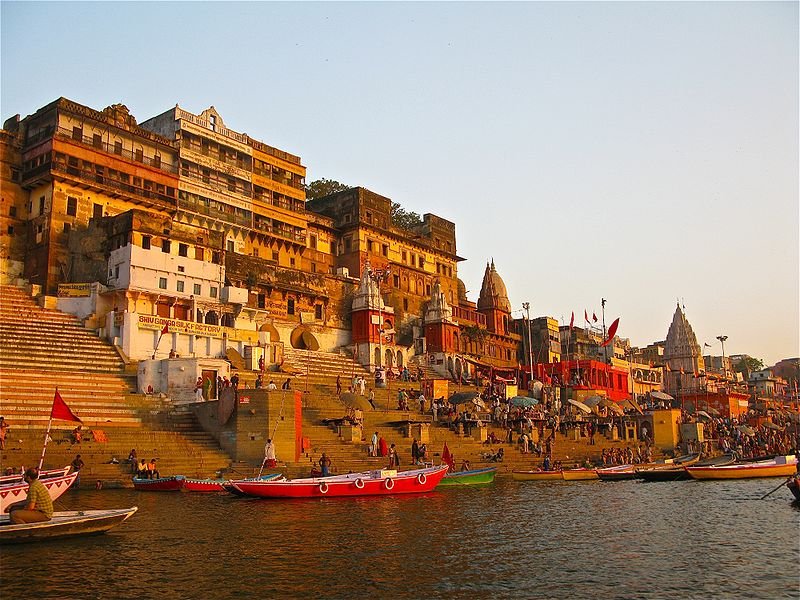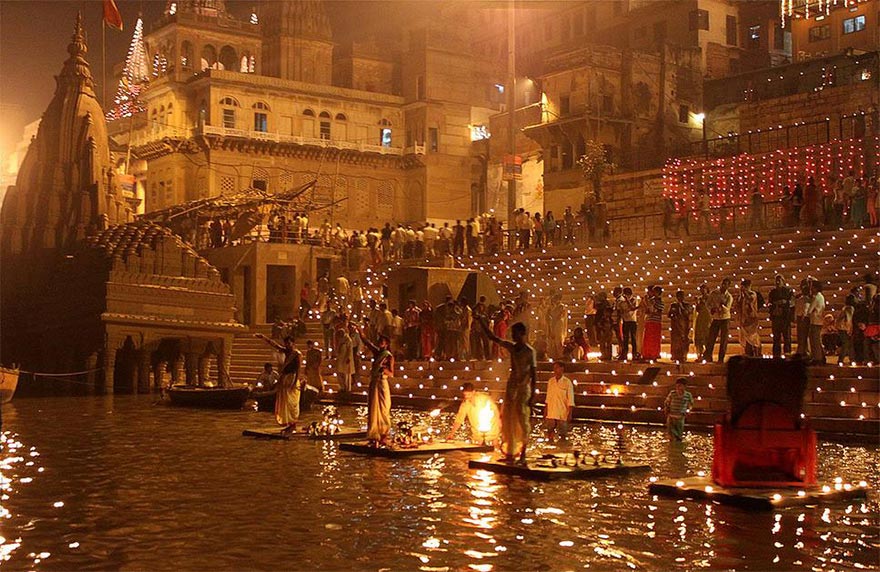It’s a perfect example of science meeting faith and technology buttressing myth. A detailed study conducted by IIT-Kharagpur – using GPS, one of the latest tech tools – could well turn the clock back on Varanasi, indicating that the holy town has been a continuous human settlement since the days of the Indus Valley Civilization, around 6000 years ago.
The project, funded by the Union ministry of human resources development (it has released Rs 20 crore just for the first phase), has even attracted the attention of Prime Minister Narendra Modi. The PM made it a point to explore the project’s progress on Sunday at Varanasi, when he met the IIT-Kgp faculty members and inquired about its possibilities and scope.
[wp_ad_camp_1]
The results that have come from a detailed geo-exploration (exploration conducted through GPS technology) conducted by seven IIT-Kgp departments, tracing the different stages through which civilization progressed, and how Varanasi has been able to maintain continuity as a living civilization, unlike comparable seats of human settlement in the world. The researchers have dug 100-metre-deep boring holes all over Varanasi to conclude that there is evidence of continuous settlement at least till 2000BC. There are enough indications that by the time the data collection is over, there would be enough to prove that this date can be pushed back to about 4500BC.
The oldest part of this civilisation has been traced to the Gomati Sangam area of Varanasi, as indicated by the underground layers that have already been tested.
It is perhaps time to take a re-look at India’s history. IIT Kharagpur is about to make an explosive announcement. It is ready to put the clock 6000 years back on Varanasi, bringing it at par with the Indus valley civilisation, if not older. What’s more, the seven departments of IIT Kgp, that are working on the project, are tracing the different stages through which the civilisation has progressed and has yet been able to maintain its continuity as a living civilisation, unlike comparable ancient civilisations around the world.
The project, which is completely funded by the union ministry of human resources development, has attracted the attention of none less than Prime Minister, Narendra Modi, who made it a point to explore its progress on Sunday at Varanasi, when he met the IIT Kgp faculty members and inquired about the possibilities and the scope of the project.
The results that have come from a detailed geo exploration through the GPS conducted through 100 metre deep bore holes all over Varanasi shows continuous settlement history till 2000 BC. The indicators are that at the end of data collection, this will be put back another ‘1500 years to establish the final habitable antiquity of Varanasi at 4500 BC.
The geo-exploration, that is being conducted jointly with the British Geological Survey, has already established the existence of Naimisharanya, a forest that finds mention in the Vedas and in the Kashipurana. This forest was considered mythological all these years.
The researchers are also trying to set up a riverine route from Kolkata to Varanasi to Prayag (Allahabad). “Since ancient times, people used this route but the advent of the railways stopped it. We are trying to re-establish that route,” said Joy Sen, a senior faculty member of the school of architecture and planning, who is also the chief of the project that has been christened Sandhi. The other departments that are involved in sandhi are humanities and social sciences, computer science, information technology, electrical, electronics and telecommunications and oceanography. The riverine route will be developed to carry tourists, said sources.
Separate heritage trails leading to the five oldest ghats – Asi, Kedar, Dasashwamedh, Panchaganga and Rajghat – are also being created. “We are tracing the ashrams of ancient yogis and spiritual leaders of all religions that dotted the lanes leading to the ghats. Some of these are extinct now, some dilapidated. We will reclaim and restore as much as possible,” Sen explained.
A large part of the project, which began in August last year, aims at creating a green rim and reclaiming the greenery and waterbodies that dotted the entire zone from Sarnath to the campus of Benares Hindu University. Efforts are on to remove encroachment and illegal constructions so that the earlier ecosystem is reclaimed as far as possible. “Varanasi has been the seat of all religions and their holy men, who will all be represented elaborately in the project. Efforts are also being made to establish special zones in areas that are dominated by old age homes and shelters for widows,” Sen added.
Language, music and iconograohy play a major role in Sandhi. Old texts like Kashipuran or Skandapuran, Mahabharata and Ramayana and the Buddhist text Anguttaranikaya are being re-read for descriptions of Kashi and Kashiraj that were considered mythological all these years.
“We are encountering surprises every day. What was thought to be lore or myth is gradually getting established as history, and that is our biggest achievement,” Sen said.
The MHRD is completely funding the project and has already released Rs 20 crores for it.
Source: Times of India



















I have to express my deep appreciation to India Divine for keeping overseas Indians like me well informed. I found the article fascinating and felt a sense of pride in knowing how ancient our civilization is. Thank you.
Shridhar
Varanasi is as Old as Indus Valley Civilization, Finds IIT Study.
Dear Scholars,
Namaste.
I would like to add a small comment on this.
Varanasi, the confluence of two stream Varuna and Asi, maintaining a Civilization not only since Indus valley but since lower palaeolithic stages.
Excavated materials prove the same.
To add some more, what is important in Varanas
First the Ganges, next the Kedara, further Kalabhairava, more further Annapurna and finally Viswanatha.
That is first Water, next Agriculture, next Dog, further Mother Goddess and ultimately God Siva.
It is further clear, water is source for existence, agriculture for production of paddy, dog for protection for household, mother goddess for creativity and Siva is the God for mankind.
Thus, it is crystal clear that Varanasi is has been a continuous habitation since lower palaeolithic times.
Thanks and Regards
I remain,
Professionally yours,
Professor VIJAYAKUMAR BABU, AVADHANULA,
Professor (Retired),
Department of Ancient Indian History, Culture and Archaeology,
Osmania University, Hyderabad-007, TS, INDIA.
(Res.Plot No. 217. Road No.6, HMT NAGAR, NACHARAM, HYDERABAD-500076, TS, INDIA)
I have been to Kasi and had a bath in the River. A great place to visit in ones life time ! D.V.J. Vittal.
1.About twenty years ago, while doing soil exploration on the banks of Yamuna in Allahabad for Allahabad Developement Authority, We met a large heap of coal buried under the ground. The configuration of the area suggested as if this was a mooring points for coal fired boats and barrages.
2. In Balrampur district, a land lord had a large barrage, which used to ply in Ganges from Hoobly to Varanasi, according to him.
For people who read history with an open mind, this does not come as a surprise at all. The modern/ western tendency has been to dismiss all old records, which were essentially oral, as myth. But a little reflection will show that no one can perpetuate pure fiction as myth or legend. The novels of a Dickens or Hardy never became legends; nor did the bluff and bluster of a Goebbels or crooked Marxists become legend. Only truth survives as myth and legend, over millennia, clothed in allegorical and symbolic language, preserved in exquisite poetic form.
Those brainwashed by western methods associate ancient civilizations with ruins. A continuously living civilization defies their imagination and intelligence alike. They assign arbitrary dates, fixing the date of creation of the world as 4004 BC, following the Biblical interpretation. The westerners dismissed Homer’s work as pure fancy. But in 1870 Troy was excavated and since then, 7 or 9 layers of the ancient city have been unearthed. So, Homer did not compose a fictitious legend after all!
Indian scientists may and must indeed adopt all the scientific tools available, but they should not follow western methods of interpretation. Dwaraka, Saraswati, Rama Sethu- everything is being proven as historical. Our investigators should not give up our own line of thinking. Indeed they will find that the so called Indus civilization is the remnant of Saraswati civilization. Varanasi is indeed the eternal city of God.
Indian civilisation started on the banks of the now extinct Sarasvati river. The Rig Veda is full of references to this mighty river which was about 1600 km long and 8 km wide at its widest. This river dried up some 4,000 years ago due to seismic changes. The so-called Indus Valley (Harappan) civilisation was actually on the banks of the Sarasvati as per satellite imaging. Our ancestors moved eastwards towards the Indo-Gangetic plains around 4,000 BC so it stands to reason that Varanasi was built around that time.
The world was created around 4000 BC according to the Bible. The early European Indologists like Max Muller were practicing Christians and their Semitic world view prevented them from accepting that any human civilisation could pre-date the Biblical date of creation. Hence they dated the Vedic age to 1,500 BCE even thought the River Sarasvati had dried up by that time.
As we use modern technology, we will be able to reconstruct our past more accurately and the findings will validate what our scriptures say about the antiquity of our civilisation.
this news is so exciting so spiritually important i cant wait for further details. please keep us in synch whenever anything more comes out . absolutely thrilling
It is a noble task undertaken by the M/HRD. It is highly appreciable and everybody should contribute to it in every way possible. As a retired Deputy Secretary to the Govt, I offer my services as a volunteer in any way they may like.
This is very interesting and doesn’t come as a huge surprise. The true history of India and links to ancient Lemuria or Kumari Kanda, now under water including the land mass of Sri Lanka, has to be established. The origin of languages of Sanskrit and Tamil (Thalakopiam) are from land of Lemuria and the original Dravidan culture. Put a stop to the falsified Aryan theory once and for all. It still survives because of the domination of the Aryan descent people in North India. History is distorted in schools on purpose. The link between sunken Dwaraka, Lemuria(reputed to be more advanced than Atlantis) and Sidhar yogi of South India Manu has to established. The extra terrestrial links between Lemurians, Sumerians etc is the the true history of mankind. Please stop the misinformation and tell the truth however shocking it may be. Search for works of David Icke, Graham Hancock and others, who’s works are suppressed. Thank You.
Jaisriram. It is very astonishing that our children are reached in their Histoty books that Vaskodigama came from Portugal to invent Bharath,while investigations and research proves that Varanasi is a City of 6000 years back.Real history and ancient culture of our country should be make known to students as well to the citizens.Central Govt should take proper steps to put facts before people keeping aside vote bank politics.If media put aside their secularistic views they can also take a good part in it.
very interesting
Dear Sir
Good day
I have to express my deep appreciation to you that our Hindus Divine for keeping and bring to our subordinates that overseas or world wide on Indians like me and well informed. Thank you.
Interesting article. But it repeats itself at many places, only adding to its length and injecting boredom. Wonder why nobody noticed that before uploading!
There could be similar discoveries in Ayodhya also.
Very true and very informative article. In fact archaeo-astronomical studies have revealed that Varanasi had civilised settlements 7000 years back
Very interesting study and rediscovery of our ancient civilization. K.N.Savalappan.
Feel proud to know the history of Varanasi.
Thanks to all those people who are doing research
on this and putting facts in this regard.
Very informative and interesting. I love the Ancient Indian civilization and also am aware that, shorn of the super-natural and / or divine interpretations, the Vedas, Srimad Bhagavad Mahapurana, other Puranas, Ramayana and Mahabharta are Itihasa or History. The tales narrated are real, but embellished with supernatural and divine interpretations. As will be apparent Sri Rama was a historic figure who lived between 9000 and 7000 years ago depending on the final age of the Saraswati Civilizations – the astronomical data in Valmiki Ramayana indicate about 7000 – 7500 years back. Similarly the sinking of Dwaraka can be dated to about 5100 years back. The events in the epic poems are actually historical, distorted during narration during the oral passing on from father to son, guru to sishya, etc. One should really look forward to unearthing historical facts without the crutch of Anglo Saxon interpretation and also our sickular – oops – secular intelligentsia. Let us look forward to more enlightenment scintificaally about Ancient Bharatavarsha.
In May month I visited Kashi & performed karma.very narrow lanes(gallis) every thing is going on.I heard from a local that Kashi never experienced any earth quake so for.
Muslim Scholars n Educated people must read articles about Varanasi n HINDU civilization way back to 6000 yrs BC.
Islam was born much..much later..trying to capture by population n their Fanatic n stupid ideas n arguments..Entire world including india..
I am at a loss to understand why should we quote about the biblical theory that the world was created around 4500 years old when there are already authentical proof of evidences of man’s existence thousands and thousands of years ago. It is therefore clear that we are not able to come out of what the British historians and indologists said earlier.This obsession should be forgotten.
In the Valmiki Ramayana in Balakanda it’s said that in Ayodhya cannons and other weapons which can throw big stones at enemies were said to be used and existing. Researchers should throw light on such matters and comeout with facts so that it will be known whether they are exaggerations or written and added later.